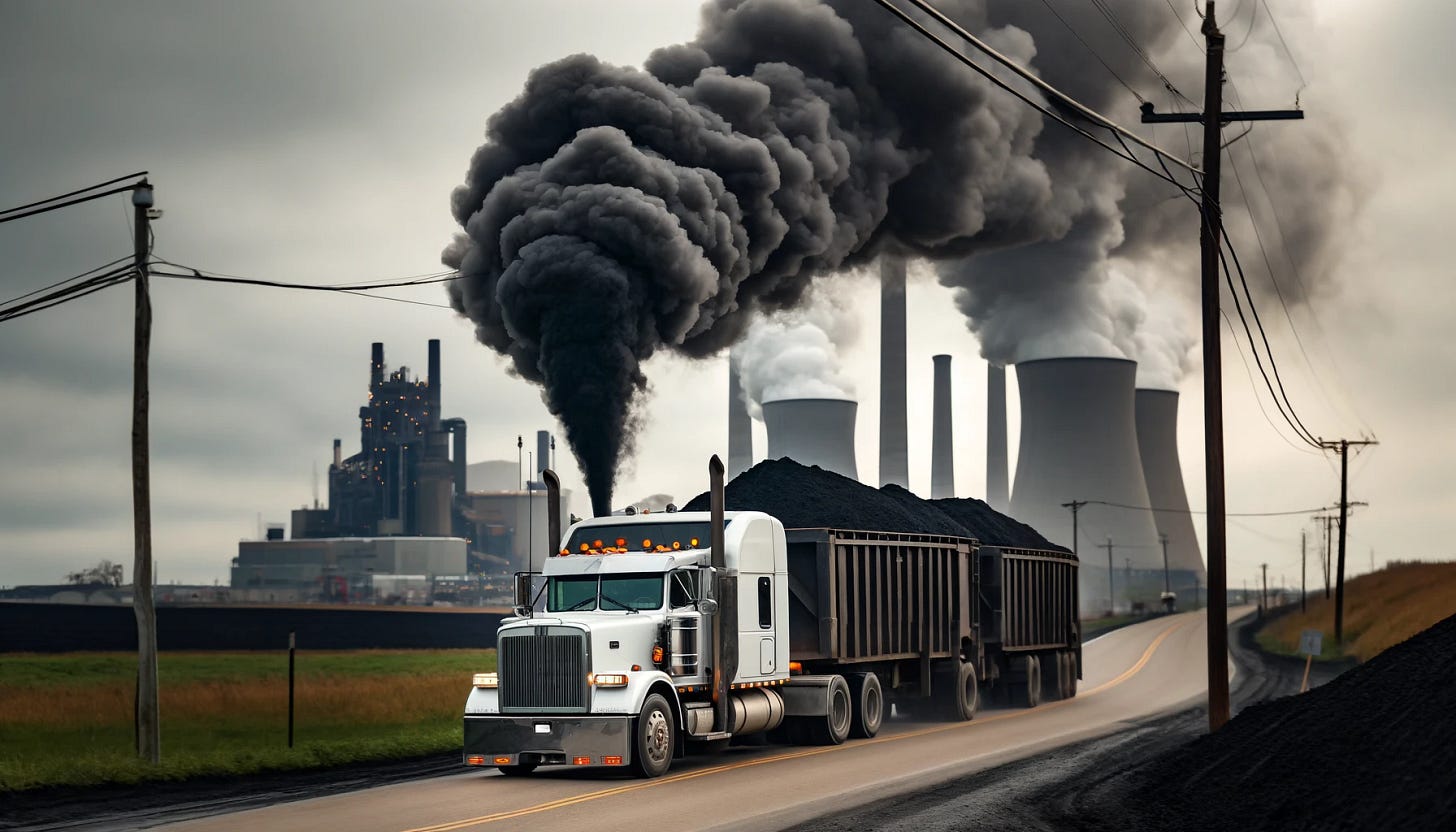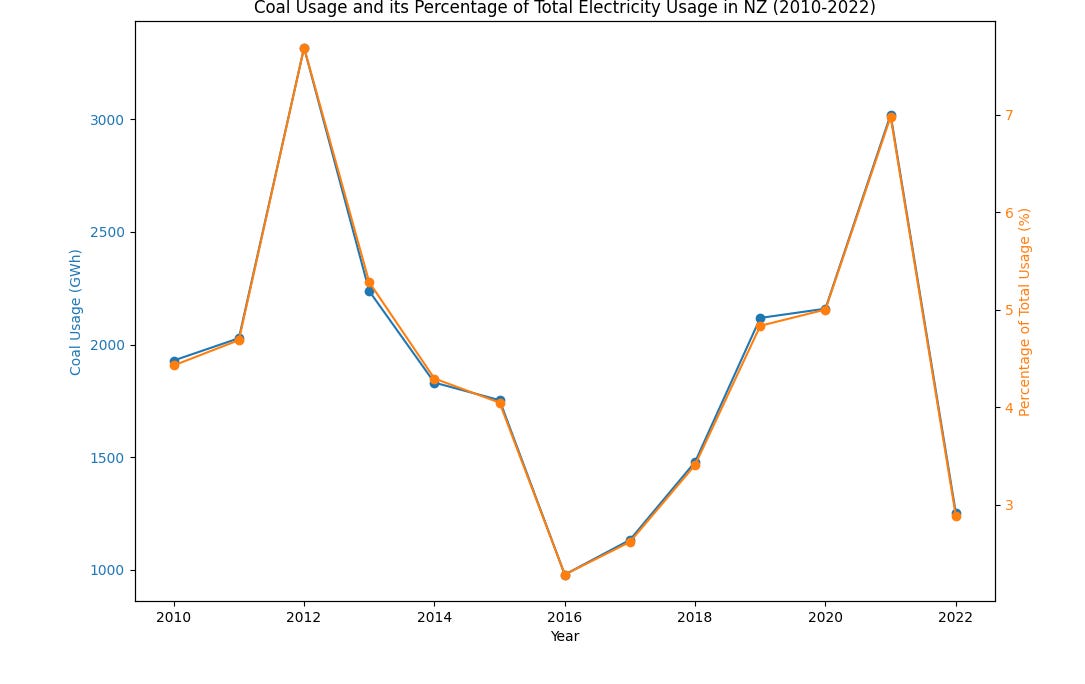Rolling coal
Some commentary following the week where Genesis "coal rolled" the industry and we almost had a blackout (or did we)?
*Edit: After a bit of discussion with an informed reader, I’ve altered some of the statements below around the low residual situation to be clearer about what the issue was. Thanks as always to anyone who finds factual errors and points them out.
This past week or so has been somewhat quieter in the NZ electricity industry, after quite an interesting one, the week of May 10. It started with Genesis Energy signalling that they are going to start importing coal again after a two year hiatus. This is somewhat of an about turn from 2018, when Genesis stated they would only use coal in exceptional circumstances from 2025 onwards. It’s not quite 2025, but close enough. Are we now in exceptional circumstances? I’m not so sure.
Memories are short and with a new CEO, it seems there are new priorities for Genesis, one of which is to ensure they extract maximum value from the rest of the industry for providing what they are calling an essential service.
I want to dive into this essential service, because it’s important that we know what we are signing up for.
It’s by now fairly undisputed that coal is a terrible thing to burn and humanity needs to stop doing this as soon as possible. Even if you don’t accept the reality of human induced climate change, it’s important to stop burning it for its negative health effects alone.
One study found that in the US from 1999-2020, burning coal was associated with 460,000 excess deaths. Another study found that fossil fuel burning, of which coal burning is a major component, caused 10.2 million excess deaths annually. These are big numbers and it’s hard to wrap your head around them. However, for perspective, consider that in the US over that same period there were ~730,000 gun related deaths. So coal burning causes a level of mortality on the same scale as gun violence in the US!
NZ only has one major coal fired power station at Huntly and I’m unaware of any studies attributing health impacts from it. However, based on overseas evidence such as that above, we can be reasonably sure that they exist.
How much do we need Huntly to burn coal so we can generate electricity? Can we cope without it? To answer these questions I’ve plotted coal usage for electricity generation in NZ in GWh and the percentage of our total electrical energy since 2010 supplied by coal. Data is courtesy of MBIE.
Coal use for electricity generation peaked in 2012, where it supplied about 7.5% of our electricity (3500 GWh). The mean over the period was about 2000 GWh (5%). So over the last ten years we can see that coal has been a small but not insignificant part of NZ’s electricity generation mix.
When Genesis and others claim that we “need” Huntly they are often conflating two issues, and the distinction is important. I have written about this before here and here when discussing EV impacts on the grid. The electrical energy supply has two primary issues to solve. Issue one is meeting our energy needs on an annual basis. Issue two is supplying that energy when it is needed (peak load). Transpower’s issue on Friday a couple of weeks ago, was issue two, not issue one (more on this below).
NZ has abundant economic renewable energy resources in terms of wind, geothermal and solar. To provide the annualised coal energy that we currently use would require the construction of only three Turitea sized wind-farms, which produces approximatley 800 GWh per year. This is well within the capability of the industry and will be achieved within the next year or two from the expected commissioning of new wind farms.
So we don’t need Huntly to meet our energy needs and solve our issue one problem. We can get more than what we need from current and planned renewables, at reasonable cost, and we are on a path to do so within the next few years.
The issue really is about peak load. What do we do when the wind isn’t blowing and the sun isn’t shining? At first glance this seems like an intractable problem. However, the solution to it is rather simple - energy storage. Genesis is proposing we store that energy at Huntly in the form of coal as it has served us well in the past.
However, the world has moved on and there are now alternatives to stockpiling coal. One such alternative is to build out batteries in combination with large amounts of diverse renewables. Once we have enough batteries in the system, then we can collect solar energy (and maybe wind) during the day - yes the sun still shines in winter, and then release it in the evening to power our ovens, heat pumps and EVs. This is already happening in California.
We have one grid scale battery in NZ, in the Waikato, another in construction in Northland and many more are planned. It’s only a matter of time before Huntly becomes irrelevant to NZ’s electrical energy picture. I understand why Genesis are pitching the narrative the way they are. They have shareholders to protect. However, I’d like to see them flip things on their head, take a leadership position and invest in batteries themselves. Afterall, they have a great place for them at Huntly.
The electricity industry’s excitement that week didn’t end with Genesis though. Due to a slightly unseasonable cold snap and several generators undergoing maintenance, Transpower identified that there could be insufficient generation to meet demand and reserves on the morning of May 10. This sounds really concerning, but the devil is in the detail. There was potentially insufficient generation to meet demand AND cover the unplanned loss of one piece of equipment.
This is known as a “low residual” situation. When the residual is positive, then there is enough reserves to cover the loss of one major piece of equipment. However, if there is no residual i.e the grid balance goes negative, then there is not enough reserve to cover an outage. Transpower, for good reason, likes to maintain a positive residual with some extra margin for safety. Typically, the residual is over 500 MW, often over 1000 MW.
So if the demand forecast eventuated during the morning peak on the 10th of May, and a large generator like Huntly tripped, then we would potentially not have enough spare capacity to make up the shortfall. In an electrical network, supply (generation) must continuously meet demand (load), so in such a situation, the system operator would be forced to shed load. This means they would talk to the local network companies and ask them to voluntarily reduce load by turning off some customers. This is what happened on August 9th 2021, and the bad press and lessons learned that day have understandably made Transpower a little gun shy.
It’s a difficult thing for Transpower to manage. It’s reasonably unlikely that there would be an outage at the specific time, so they could have stayed quiet, crossed their fingers and most likely everything would have been ok. However, if there was a problem and they had taken that approach, I imagine that the press and subsequent commentary from the politicians would have been very negative indeed.
So Transpower pulled the “ask the public for help” card. The public responded and Transpower estimates that collectively demand was reduced by about 260 MW during the morning peak. The difficulty with this approach is that it feels like they can only play this card once. It’s unlikely the public will be so sympathetic next time. A lot of the media coverage following the call to save power was still extremely negative. We are not even officially in winter yet, so what are Transpower going to do when we get the next low generation balance situation, possibly as soon as next month?
This situation highlights that we urgently need more peaking capacity in NZ. This can be driven in part by intelligent demand management e.g hot water ripple control, and smart EV charging. However, we need good consumer incentives to encourage this. The other technology that will play an increasing role in our renewable system will be grid scale batteries. These can and will get us through the peaks to come.
As usual, interesting times ahead in the energy industry.




Your article puts great perspective on a difficult situation. It should be published so others understand. Liked reading it.